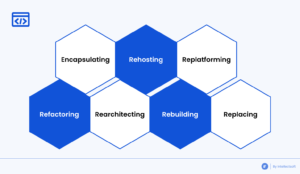As technologies evolve at a breathtaking pace, legacy systems are the businesses’ weak points. Outdated software usually results in poor performance and scalability which leads to your stagnation and limits your development possibilities.
The latest research unveiled that 69% of enterprise architects have hardware dependency as the main reason to modernize their legacy systems. Speaking of CIOs and Heads of IT departments, they consider business competitiveness (65%), security (58%), and integration (54%) as the primary reasons to transit to a modernized system.
The solution to this problem is clearly legacy system modernization. However, in order to successfully complete the transition, it’s paramount to understand the essentials of this time-consuming process.
It’s worth noting that according to the Mainframe Modernization Business Barometer report, 74% of organizations have envisaged a legacy system modernization project, but failed to complete it.
The modernization of legacy systems is quite challenging so before even beginning, you have to dive in to avoid the mistakes of those businesses that failed. If you want to know more on this topic, keep reading this article to find out what a legacy system is, what legacy system modernization approaches are, and so much more. So let’s get started to have all your questions answered!

What Is a Legacy System?
Let’s begin with defining what exactly a legacy system is. Basically, it’s an information system based on outdated technologies, and replacing them will lead to the interruption of systems functionality. Such a system blocks future business development, doesn’t enable the smooth integration of new features, and significantly slows down the daily operations.
Simply put, it’s very difficult to maintain and extend. In addition, legacy systems involve plenty of hidden costs for maintenance, security, compliance, and lost business opportunities that devour your budget. The indispensability of legacy system modernization is required not to drag your business down and to minimize risk exposure.
What Is Legacy System Modernization?
This definition is very straightforward as it means updating all or some parts of your existing IT legacy system to improve all business processes and achieve main company goals. Usually, it’s a switch to a modern programming language, and software libraries/protocols to avoid all risks and inconveniences of an outdated system.
The modernization of a legacy system is an integral part of driving the latest innovations and getting the most out of them. Legacy software requires some solid resource investment for its maintenance, and it’s very difficult to find a qualified specialist who can support the outdated system.
In addition, it’s hard to integrate legacy systems with new features and systems as there is a big risk that it would crash at any time and disrupt all the internal processes. Such software is so inflexible, so making any improvements is almost impossible. In order to eliminate this barrier and prevent your business from having a significant technical debt, don’t postpone the modernization of your legacy applications to stay competitive.
6 Top Reasons to Consider Legacy System Modernization
1. Reduced Maintenance Costs
After modernizing your legacy system, operational and maintenance costs will be drastically reduced. All tedious and time-consuming manual tasks will be automated and there will be no need for costly developers to maintain the system.
In addition, no costs will be spent on employee training, hardware components, and technological upgrades. According to multiple reports, companies spend around 60-85% of their IT budget to upkeep the outdated systems, therefore failing to achieve their main business goals that are aimed at improving ROI. And it goes without saying that the expenses for maintenance of legacy systems will only increase in the future.
2. Improved Compatibility
Those companies that rely on their legacy system always face plenty of compatibility issues and it’s quite challenging to adopt new IT infrastructure. As a result, a lot of time and financial resources are channeled into keeping the legacy system running.
It’s paramount for your system to get synced with the newest applications and tools. With legacy modernization, the systems will be up to date with the evolving technologies which will enable smooth and seamless integration. It’s pivotal to re-engineer the outdated software to reinforce business operations. By introducing the future-driven technologies, you will afford better functionality, and ameliorate your software’s compatibility and user-friendliness.
3. Minimized Risks of Security Threats
Needless to say that the decent level and quality of the company's security is imperative. Unfortunately, due to their vulnerable and obsolete nature, legacy software is a perfect target for malicious activities. They are much more prone to data leakage, malware, and their resistance to cyber-attacks and data breaches is significantly lower in comparison to modern systems. Moreover, disaster recovery and data backup are also a big concern.
It all can cause several serious problems to the functioning of your enterprise. The absence of security updates and lack of compliance with modern security standards put the company with the legacy software at high risk. After the technological refreshment and modernization of legacy systems, you will be able to minimize those risks of security threats and protect business-critical data.
4. No Hardware Dependency
Another big issue is the fact that legacy software depends on in-house hardware. Technologies evolve very fast and right now most companies already made the transition from on-premises to cloud platforms. This is a much better and more efficient solution that can also reduce infrastructure expenses. By modernizing your obsolete software and switching to the cloud you will ensure better accessibility that will have a positive impact on the overall company performance.

5. Optimized Business Processes and Business Continuity
With the modernized system, you will be able to better serve your customers and significantly improve the overall user experience which will ensure the ultimate business continuity and exponential growth. It will enable you to offer the most convenient and automated services.
Speaking of the business operations, your legacy software can not completely support it as you grow. Over time, it starts slowing down and crashing regularly. It hinders your capacity to adopt the latest innovations and doesn’t meet your fast-changing business requirements. The modernization will allow you to leverage evolving IT architecture so you can expand your operational activities and effectively manage your business needs and make your workflows more efficient.
6. Better Performance and Productivity
Your internal IT resources are the most valuable asset of your organization and their work time drives your company forward. Obsolete legacy systems are a serious obstacle in the daily workflow of employees as very often they have to complete different tasks manually which is very time-consuming and counterproductive.
A refreshed automated system will enable you to streamline all activities, optimize the performance of your teammates and boost productivity and efficiency. It requires much less input from your software engineers so they can concentrate on the tasks that will bring tangible value to your business. System enhancement can assist you in overcoming potential bottlenecks and inefficiencies. As a result of increased productivity, you will reduce the costs, downtime as well as manual labor of a priceless workforce.
7 Legacy System Modernization Approaches
1. Encapsulating
This is the technique that implies reusing the core legacy software components. At the same time, you omit the legacy code and leave it in its environment, and it will be connected to the new access layers via APIs. This approach will enable you to extend the features and bring more value to the system.
Your old components will be provided with the new interface to leverage the overall software functionality and improve the accessibility to other system components. It’s worth noting that the encapsulation approach won’t be able to fully resolve the maintenance and upgrading challenges, however, it has the full potential to reduce your costs and minimize potential risks. This option will be applicable if the quality of your code is already good and your legacy software already has a huge business value.
2. Rehosting
The rehosting approach enables easy redeployment of an application component or the whole system to another infrastructure (for example, cloud, virtual, or hardware environments). It also doesn’t require modifying or recompiling any code parts, features, or functions. Even despite the fact that this approach is usually just one of the steps in the migration process, it will help you cope with support issues connected to open systems like SQL or cloud environments.
This technique involves low risks and because of it, many big enterprises opt for this particular option to amend their performance without disrupting the workflows. This option will be of the lowest cost and implementation risk for your company and it will have zero negative impact on business processes because of the high speed.
3. Replatforming
The replatforming approach enables you to migrate the legacy system components to a new platform while applying minimal changes to the code in order to adapt the renewed platform to the new organization’s needs. The code structure itself as well as features and functions don’t undergo any changes.
This option is very convenient for those businesses that are not willing to modify the system a lot or are concerned that users won’t be able to effectively use the system. It’s important to understand that those minimal changes mean that you will only be able to adapt to the new system components and others won’t stay up to date with the current market.
4. Refactoring
Refactoring is the process of restructuring and optimizing the internal components of your old software without changing its external environment. It’s the best solution to get rid of your technical debt and improve the components’ features and structure.
If you opt for this approach, it will allow you to make modifications in the configuration, and improve the quality of your code while eliminating tech issues, and making it more maintainable and clear. The refactoring technique will make your system flexible so it can be adjusted according to the current organization's needs.
5. Rearchitecting
This particular approach means altering the system so it’s possible to shift to new application architecture and get full advantage of the much better capabilities of the platform. Rearchitecting is the technique of medium cost and risk as it can change the business logic and the way the system functions in general. But in the end, it will allow you to resolve the main performance and scalability issues that you previously encountered.
You will get plenty of benefits that will help you significantly improve the system functionality and streamline the innovative features integration process. We should warn you that this process is very complex and requires some solid tech skills.
6. Rebuilding
Rebuilding, also known as redesign, is a technique that consists in rewriting the system components from scratch while preserving its specifications and scope. It could be considered a convenient custom solution for your organization. The legacy system components are rewritten according to the new business vision, and the process gives you access to new features, better functionality, and the possibility to effectively leverage the capabilities of the latest technologies and third-party platforms.
With the new coding techniques, it’s possible to reduce the development time, ameliorate security, as well as generate custom network protocols. However, you should take into account that this approach is more high-risk as a lot of changes are being made to the original system.
7. Replacing
The last modernization approach is replacing which implies eliminating the old software components and replacing the entire app with a new tool that corresponds to your current business requirements and needs. Do some research and analysis, come up with new business logic and adopt a new system that will have up-to-date and relevant functionality.
Which One of Legacy System Modernization Strategies Will Work for You?
You have just made sure that if you take the road of legacy system modernization, there are various approaches that you can opt for. But how can you choose which one is the perfect solution for your company and will work best for you?
The decision-making process will be tough due to a wide range of options. It’s important to understand that every legacy system is unique and you have to thoroughly analyze your existing software to know how to move forward. What can work out for one company can be an irrevocable mistake for another.
In case you don’t know what to do next, it’s better to consult with an experienced company knowledgeable in legacy system transformation. You can feel free to book a free consultation with Intellectsoft specialists who will guide you through the process and will help you make the best well-informed decision that will start your path to modernization.
Final Thoughts on Legacy System Modernization
No matter what approach to legacy system modernization you choose, it’s a very risky and complex process. Nevertheless, you should understand that the final result will definitely be worth all the contributions. The digitalization across industries will be only picking up pace, so going through modernization of your systems is inevitable and the sooner you start it the faster you will take your company to a whole new level.
At Intellectsoft, we have gathered the most skilled and experienced industry specialists who have robust expertise in offering legacy software systems modernization across industries and are familiar with different approaches to the process. It’s the right time to start renovating your legacy systems to boost your business growth through the power of technology.
Don’t hesitate to contact us and get more details regarding our legacy system modernization services. Our dedicated specialists will guide you through the processes and will provide you with all the information you need.

